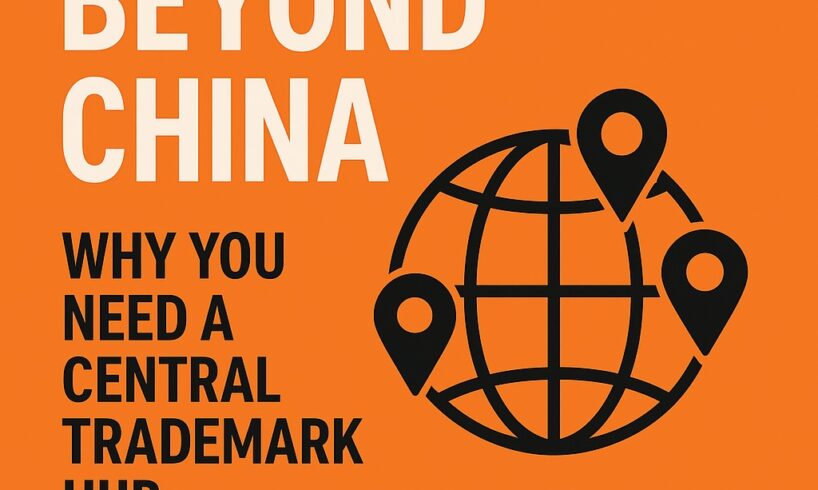
What we’re seeing as companies diversify beyond China
In recent years, a large chunk of our work has been helping long-term and new China clients shift manufacturing and supply chains to other parts of Asia, as well as to Latin America and Europe. As they diversify, the same problem keeps surfacing: their international trademark (and, more broadly, IP) portfolios have dangerous gaps.
As they enter new markets, some companies end up relying on scattered local counsel, leading to fragmented portfolios that create real risks: missing coverage, inconsistent ownership, and overlapping filings.
Consider one case. A medical device manufacturer operated in China for 15+ years with strong trademark protection. When the company shifted a chunk of its production to Vietnam and began selling in Thailand, it learned that a local distributor had already registered their core brand name in both countries. The business strategy went global, but the brand protection strategy did not keep up.
Centralizing oversight with an experienced international trademark law firm closes these gaps and saves money and time while reducing risk.
Why consolidation matters as portfolios grow
As businesses expand across countries and product lines, trademark portfolios sprawl. Work gets split among multiple firms and local agents. The result is duplicated effort, inconsistent advice, and blind spots that create legal and operational risk. Centralizing oversight under one trademark law firm restores control, consistency, and strategic alignment.
Where fragmentation leaks value
The failure modes are predictable. Different local counsel may file unnecessarily similar trademarks, choose the wrong classes, or repeat searches, driving redundant filings, maintenance, and review costs. One electronics company filed two applications for the same mark in Germany through different agents, wasting thousands of dollars in filing fees.
Coverage gaps are common, too. Without a central plan, priority markets get overlooked and expansion collides with prior rights that could have been avoided. And when subsidiaries receive uncoordinated advice, they adopt slightly different versions of core trademark assets, weakening the brand’s position in refusals, oppositions, and enforcement.
Unified oversight means a single trademark strategy
When one trademark law firm coordinates the entire portfolio, every mark, U.S. and international, fits the same trademark protection plan. Marks interact with product names, logos, slogans, domains, and licensing terms. A single team keeps specifications, ownership records, and priority claims consistent, which simplifies trademark enforcement, licensing, diligence, and acquisitions. The same logic applies to coordinating activities involving other IP rights, such as copyright and design patent registrations.
Your trademark hub can coordinate your global protection
A single trademark hub with international experience can serve as your operational center. It sets strategy, directs local counsel, aligns timelines, and standardizes evidence and identifications so every local action supports your global plan. In practice, that means one place for instructions, one calendar for deadlines, one standard for identifications, and one playbook for refusals and oppositions.
Technology is part of the advantage. Specialized docketing software enables secure data transfer, encrypted storage, and real-time dashboards for legal and business stakeholders. You get reporting without chasing spreadsheets across time zones.
A seasoned international trademark team also adapts to your structure, transitioning matters to trusted partners where helpful or continuing with existing local counsel when that is in your best interest. You keep local expertise while gaining global consistency.
Communication and accountability get simpler
When responsibility is spread across multiple agents, important details often fall through the cracks, including missed renewals, unrecorded assignments, outdated/inconsistent ownership data, and unresolved local disputes.
Centralization gives you one point of contact who understands business priorities, tracks every deadline, and acts quickly. Reporting becomes consistent, decisions get faster, and budgeting is easier because billing flows through one channel.
Efficiency and cost control over the long term
Consolidation can look complex, but in practice it reduces total spend. Eliminating redundant searches, duplicative drafting, and overlapping filings often yields a 10–20% reduction in annual filing-related outside counsel costs.
A unified docket and clear playbooks also lower the risk of missed renewals and delayed office-action responses. Preventing a single missed renewal can avoid thousands of dollars in fees and potential loss of rights. A consistent clearance and filing strategy also reduces the odds of avoidable disputes.
Unified reporting adds further value. Standard dashboards show what you own, where protection exists, and which actions are due, so budgets track reality.
What a smart consolidation looks like
Begin by inventorying marks, applications, deadlines, and agents, and resolve any ownership or chain of title issues. Map the portfolio to business priorities by market, product, and risk. Standardize specifications and classifications so goods and services align across jurisdictions.
Next, put in place global docketing and watch services, a clear reporting cadence, and defined escalation paths. Keep effective local counsel where they add value, replacing only where gaps or inefficiencies exist. If useful, migrate in phases, starting with priority markets or near-term deadlines.
How to choose your central trademark/IP counsel
Look for a trademark lawyer or law firm that knows your key markets and has lawyers or other personnel who can work directly in local languages. Active participation in groups such as INTA or international lawyer networks shows global connectedness.
Confirm experience coordinating international trademark portfolios and handling refusals, oppositions, and transactions, and expect secure technology with encrypted file transfer, role-based access, real-time status, deadline alerts, and board-ready reporting.
Frequently asked questions about centralizing trademark oversight
Who should consider consolidating their trademark management?
Companies with trademarks in multiple countries, multiple product lines, or a mix of outside firms and agents, especially those shifting manufacturing or sales away from China and into new markets.
Do you need to replace your existing local trademark counsel?
Not necessarily. Keep effective local counsel where they add value. A central U.S. trademark hub coordinates strategy, standards, and deadlines while directing local representatives. And it is often easier for local IP counsel to speak “IP” to counterparts in other countries, than to clients directly (or even their lawyers, if they do not specialize in trademark matters).
What does the transition actually involve?
Inventory the portfolio, correct ownership and chain of title, standardize goods and services, migrate docket data, and set reporting and escalation workflows.
How long will trademark consolidation take?
Timing depends on size and quality. For 10–100 marks, a full transition, including data gathering and powers of attorney, typically takes around a month or two.
Will consolidation increase our legal spend?
Short term, migration is administrative. Long term, most clients see lower total spend by eliminating duplicate tasks, rush fees, and inconsistent filings.
What about Madrid Protocol versus national filings?
Both can easily fit a centralized model. Your hub determines where Madrid is efficient and where direct national filings are stronger based on risk, scope, and enforcement needs.
What if our records are messy?
Cleanup is part of the consolidation. Align owner names, record assignments, update addresses for service, and cure gaps so the portfolio is diligence-ready.
Final thoughts and next steps
Trademarks are core business assets. A coordinated, top-down program protects those assets through consistency, clarity, and speed, while preserving the local expertise required for national procedures. Local representatives remain essential. Your brand should operate as a single global IP system, not a collection of disconnected parts.
Our law firm does not charge fees to assume oversight of existing trademarks. If you want to consolidate your trademark portfolio, we can review your current marks, agents, and deadlines and return a prioritized plan and schedule. Contact us to discuss a no-cost transition and a unified, data-driven trademark program that lowers risk and total spend.





